
There’s no question that X Games does a phenomenal job promoting its athletes, oftentimes elevating them to household name celebrity status. Over the years countless individuals have been morphed into charismatic icons, all under watch of the public eye. Since adding Rallycross to its calender in 2006, X Games has undoubtedly pumped some much-needed interest into the sport, but as great as it is to see motorsport brought to a new audience there’s one area that I wish they would touch on more – the cars.
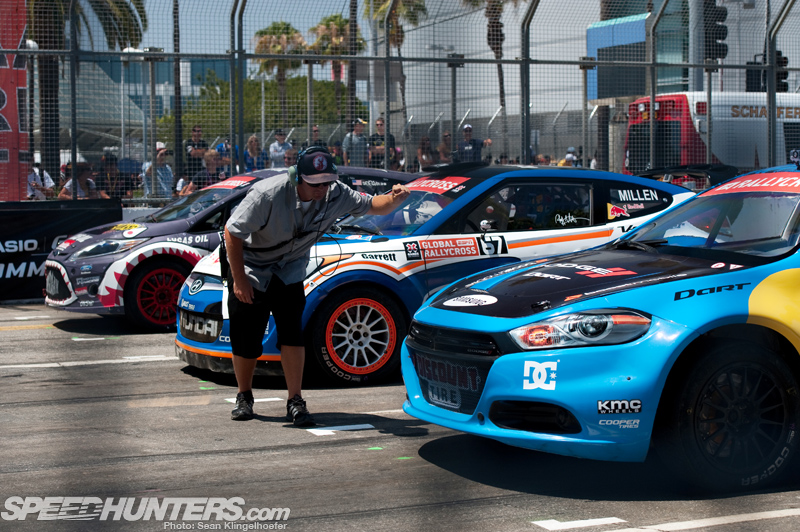
Since I haven’t been living under a rock, I’ve been aware of Rallycross for some time now, but last weekend would be my first up close taste of the sport. Regardless of your opinion of Rallycross, one area we can always find interest in are the machines themselves and I always find it fascinating to take a peek under the skin to see how the beasts tick.
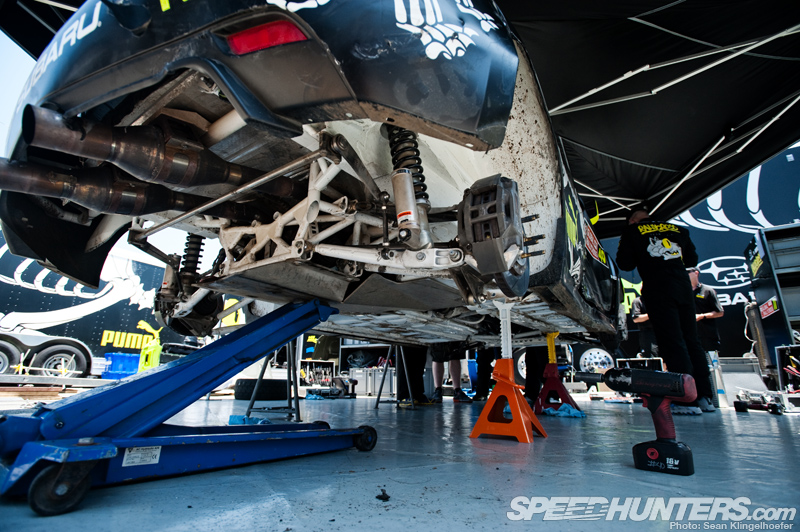
Being a Rallycross rookie I knew going into the weekend that what I was most looking forward to was getting a good look around the cars. On the outside they appear to be quite similar to the cars you would see in WRC, but they are in fact built to a slightly different standard for Rallycross. As with any major form of motorsport there are rules and specs the cars must meet, but that doesn’t mean all cars are created equal.
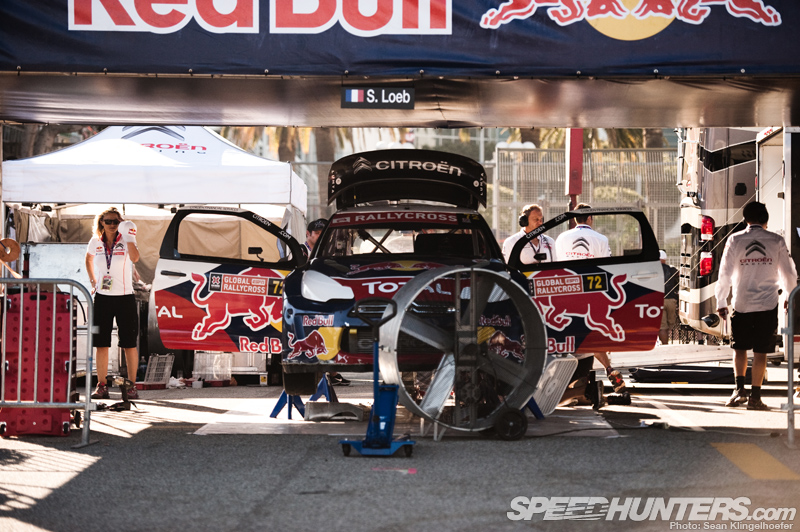
Although they only need to run for short intense sessions, the cars are built to a very high standard and should be considered top-notch builds. I can assure you each and every last component is selected, tested, adjusted and redesigned specifically for this purpose and each team wiggles the rules into their favor. While there is some cross-over between standard rally gear, much of the components are specialized for Rallycross.
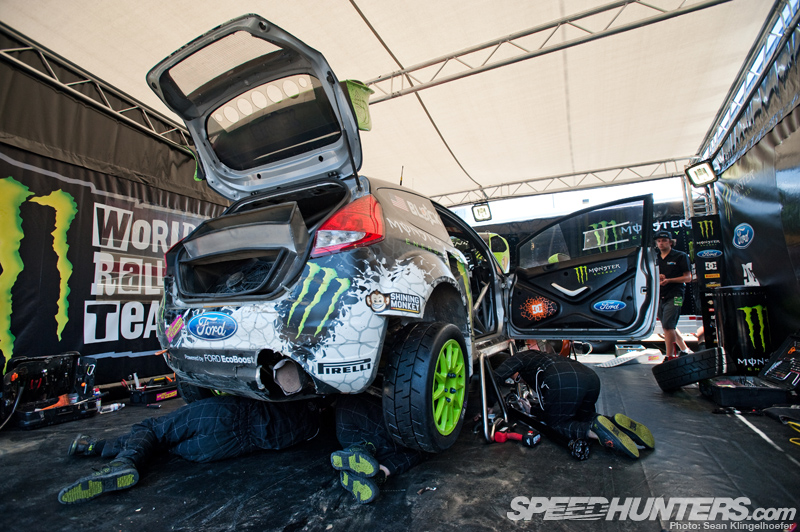
As you may already know, Rallycross is a pretty violent form of motorsport and crashes are quite common, particularly at X Games. Keeping this in mind, the cars are built to be as safe as possible. Many components seem to be designed to break-away easily, but they are also designed to be repaired almost as quickly as they are broken. At virtually any time during the course of the weekend cars could be seen with a swarm of mechanics under them.
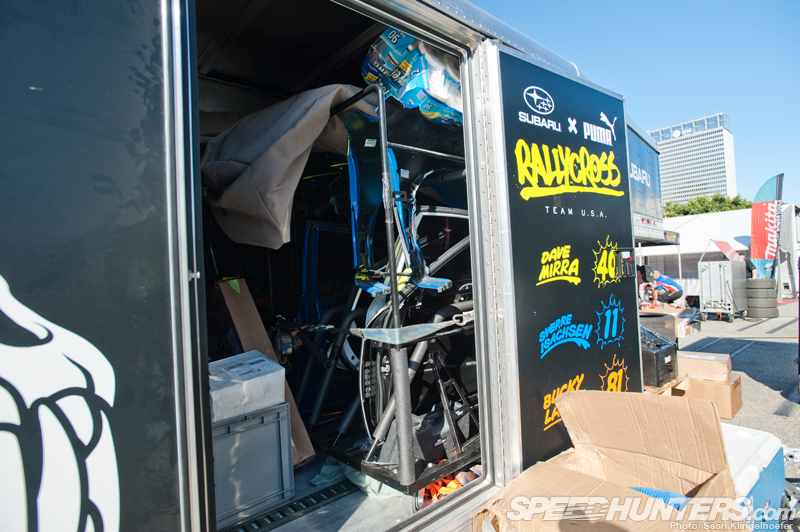
In fact crashing is so common that it’s almost unheard of that every car returns from a heat without at least a small ding. A general rule of thumb for motorsport is to show up with four spares for every component on the car for the weekend. I wouldn’t be surprised if Rallycross requires a slightly larger inventory. The guys at Subaru seemed to have a limitless supply of additional panels ready to go at the drop of a hat.
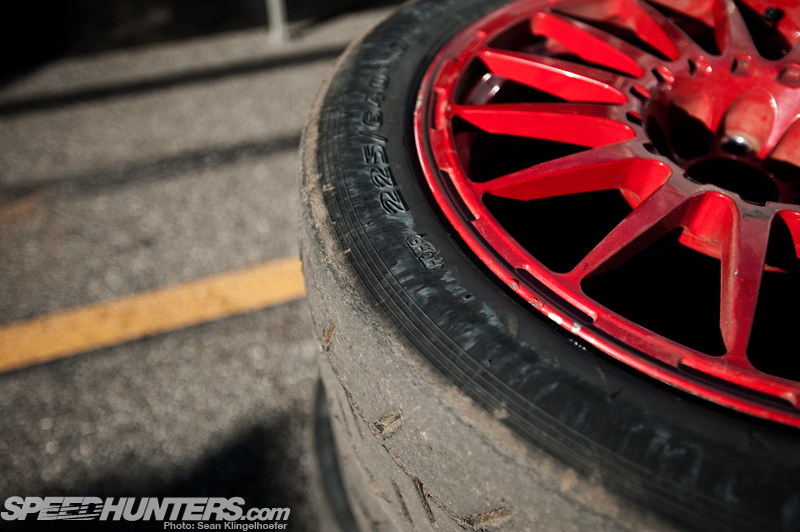
Unlike years past, for 2012 Cooper Tire has been named the spec manufacturer for Global Rallycross, the body who governs the X Games event. Having all the competitors running on identical rubber helps level the playing field quite a bit.
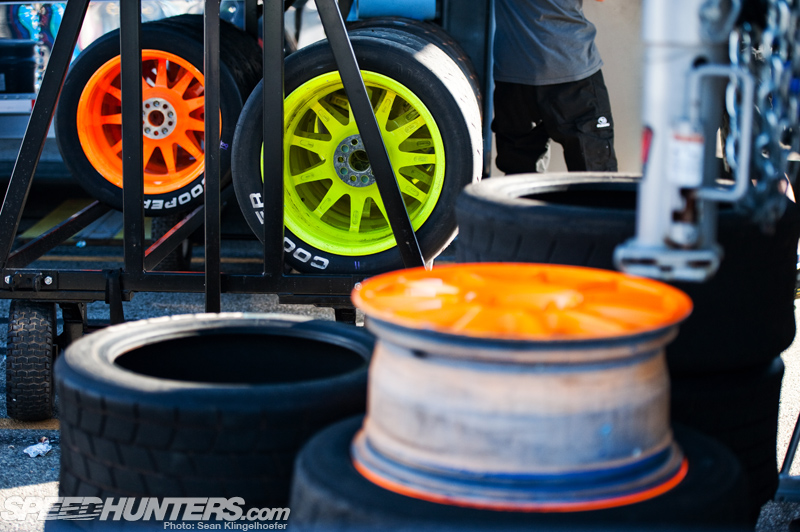
I don’t know if there is a restriction to the amount of tires allotted to a team for the weekend, but it seemed as if they were installing fresh ones constantly. Utilizing a spec tire definitely helps take away some of the stress revolving around strategy, but things can still go wrong.
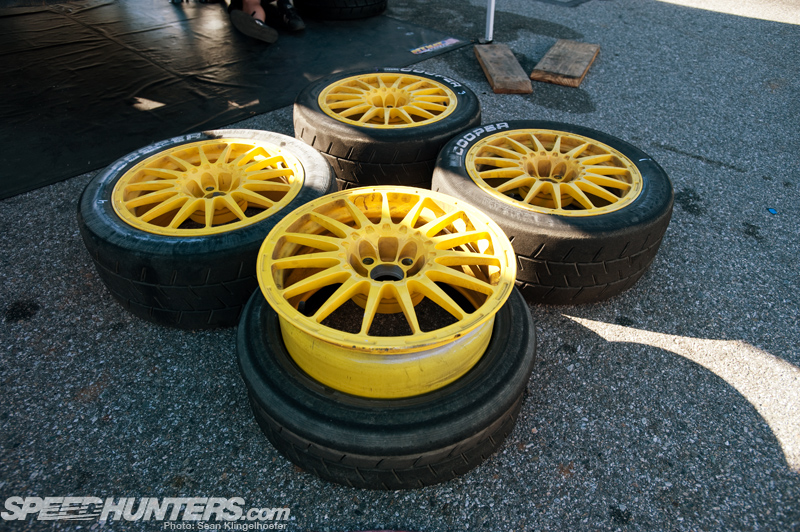
Given the unique surface characteristics of Rallycross, seeing tires popping off the bead was a common occurrence. On several occasions I saw cars coming off the dirt jump at the entry of turn four sideways. When you combine that type of lateral force with the grip levels provided by the asphalt landing you have a guaranteed recipe for a de-bead.
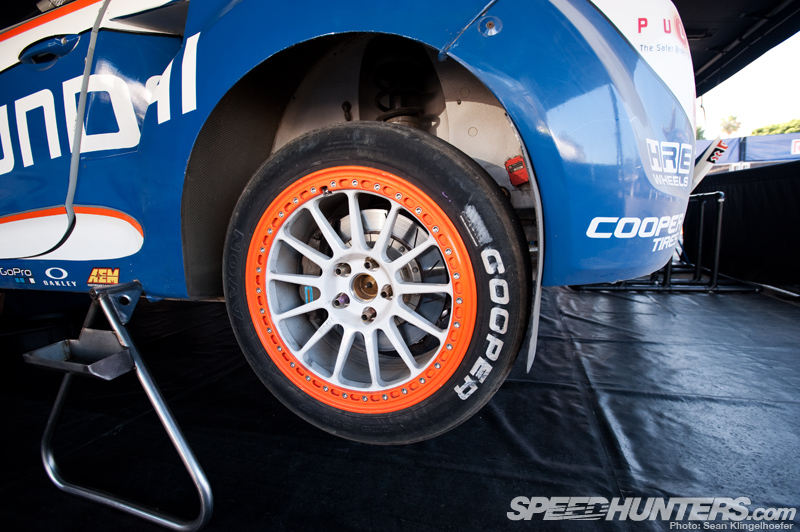
Which is why I found the solution on Rhys Millen’s Hyundai quite clever. The HRE RX43 wheels have adopted a long time technique used in off-road racing utilizing a bead-lock to prevent the tire from removing itself from the rim. It’s simple, it’s effective and it’s not against the rules. I love it and suspect by 2013 the entire field will follow suit.
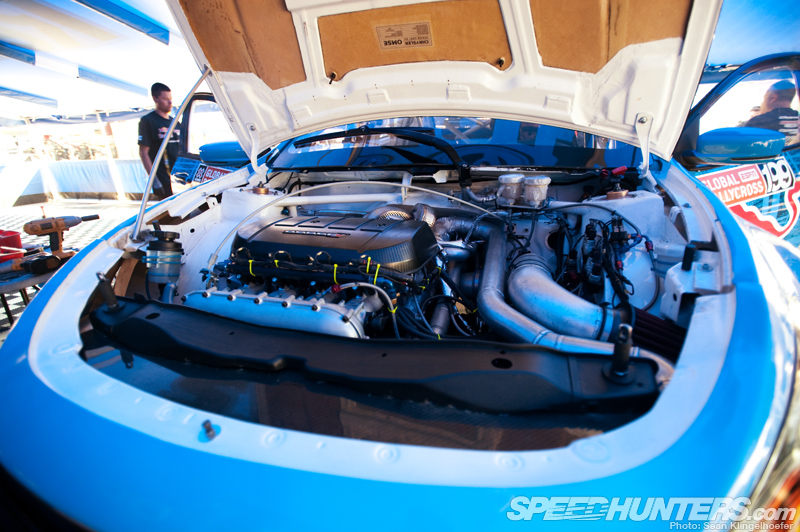
Propelling each of these cars from 0-60 in a mere two seconds is a two-liter four-cylinder turbocharged power plant. Each engine is rated somewhere between 500-600bhp, but exact numbers are hard to prove or disprove. Each team has their own way of achieving these performance numbers, some, like Travis Pastrana’s Dodge Dart, are seemingly straight forward.
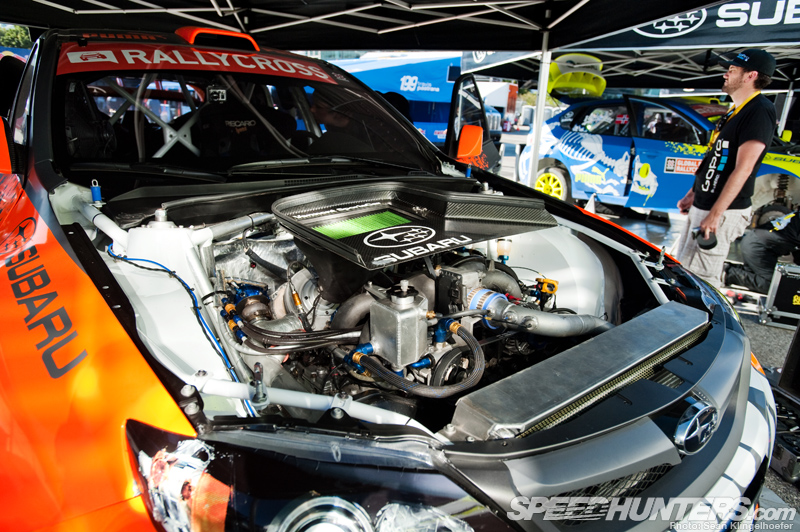
While others, like Subaru’s odd-but-proven boxer, appear to be a little more complex. Regardless of the layout, each engine is built to withstand the punishment of Rallycross and as such is fitted with top-shelf internals, a modern sophisticated turbocharger and military-grade wiring and plumbing.
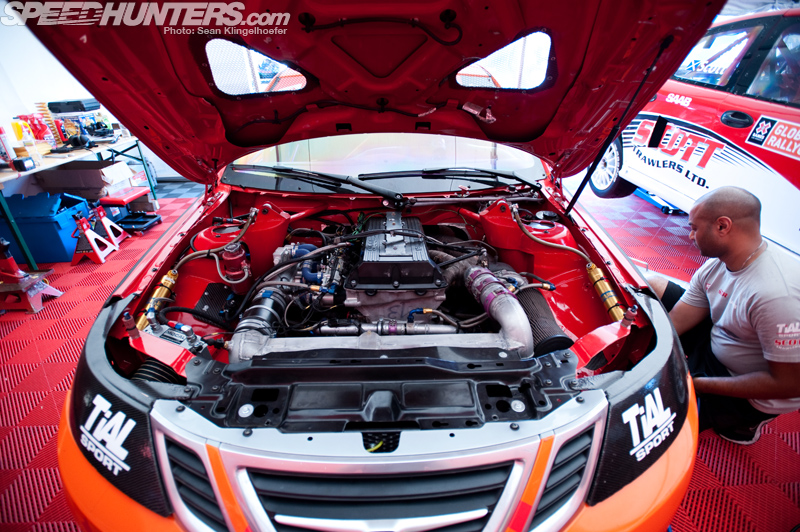
Even the casual enthusiast knows that heat is a common issue with any turbocharged engine, but when you’re constantly running at the ragged edge of redline, anti-lag firing and all, it becomes an even greater concern. Many of the hydraulic hoses and miscellaneous bits are covered in heat barrier tape to prevent any performance degradation.
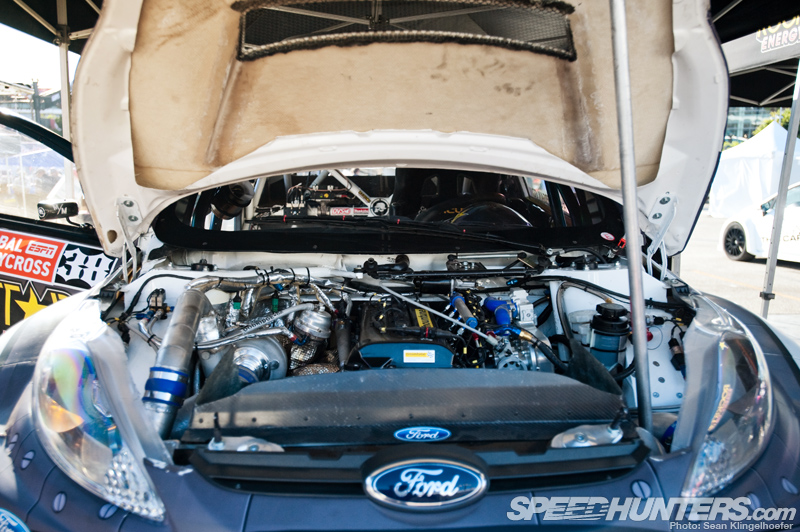
Most of the cars use a transverse engine layout, aside from the Scott-Eklund racing Saab 9-3 and the Olsbergs MSE Ford Fiestas. Both of these cars came from the factory with transverse layouts, but have been converted to longitudinal to accommodate the style of gear boxes they are running. This also allows unique packaging options for other items like the turbo and intake manifolds.
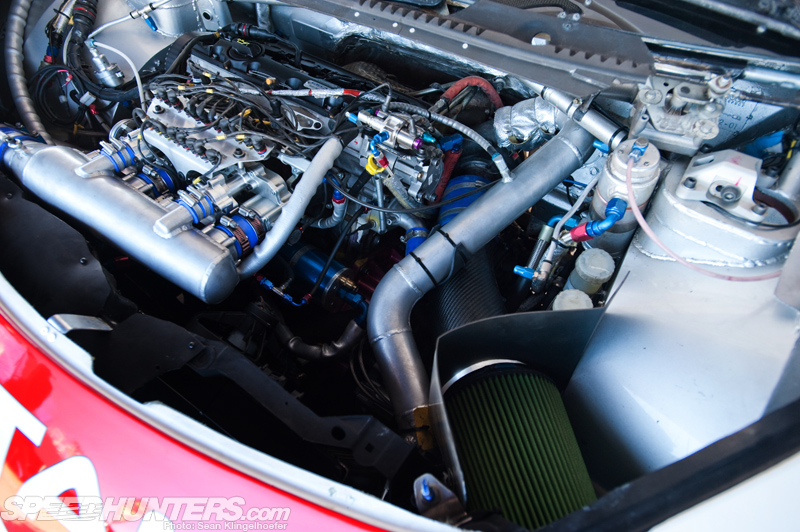
Under the hood of eight-time WRC champ Sebastian Loeb’s Citroen things were as tidy and professional as you’d expect to find from a world champion team. Every last inch of the bay was occupied by precision components which have been expertly routed. Just look at that electrical junction resting atop the throttle bodies… wow. Just amazing.
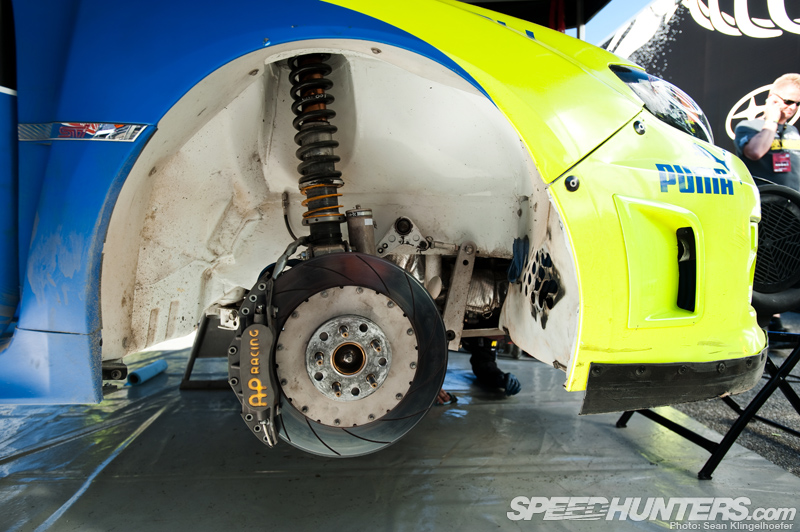
It goes without saying that proper footwork is also critical to achieving a good result. Virtually every car had a nearly identical setup with a MacPherson style front shock, hollow sway bars, floating rotors and multi-piston calipers. While the suspension and brakes are simple in theory, these are very high tech setups.
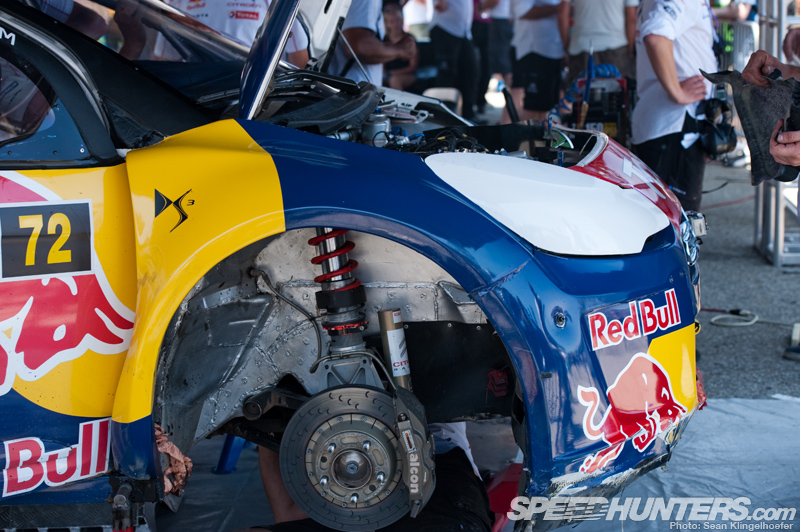
The shock absorbers feature external reservoirs to help dissipate heat built up from the extreme suspension travel demands of Rallycross. While many will see what appears to be a massive inverted shock rod inside the spring coils, the front shocks actually have an outer cylinder that rides on a ball-bearing sleeve which helps displace any sideways loads (remember turn 4) to protect the real rod hidden inside.
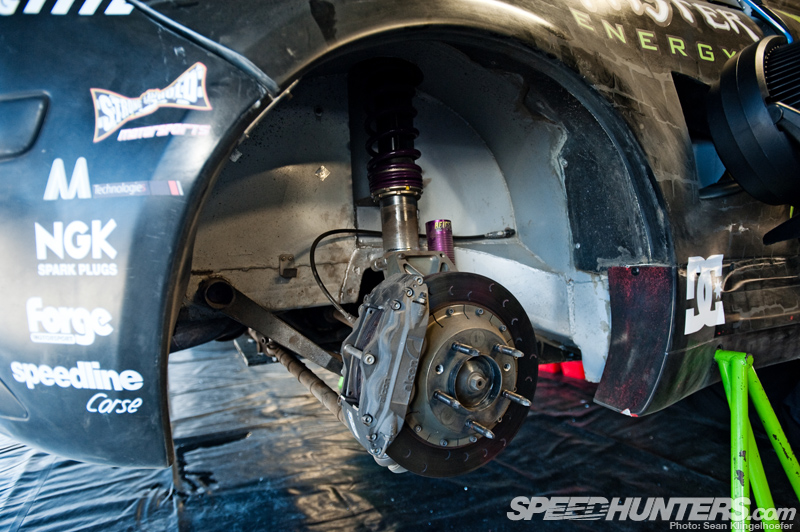
In the rear you can expect to see more of the same, but a little less beefy since, for the most part, the rear of the car is just along for the ride. Note the trick uprights on the back of Liam Doran’s Citroen, very similar to what we saw on the front of Loeb’s car above.
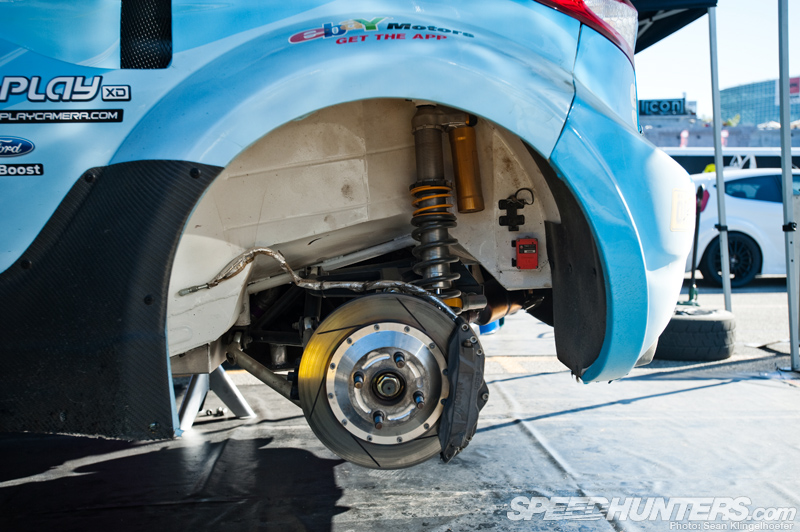
Those with a very discerning eye may have noticed that one thing missing from all corners are wheel speed sensors. This is because Rallycross rules don’t allow for ABS or traction control, all acceleration and deceleration must sorted out by man and machine without electronic interference. This goes for the center differentials as well, active diffs are illegal.
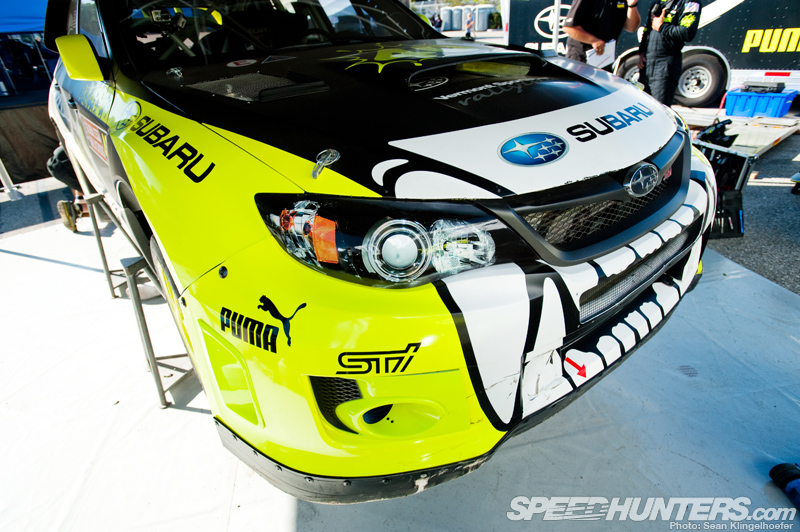
Since Rallycross occurs during the day the cars are missing the robust lighting often associated with Rally. In fact the cars don’t even have headlights, most teams replace them a lightweight cover usually constructed of carbon. Some cars like the Vermont Sportscar Subarus apply faux headlight decals so as to more closely resemble the factory car.
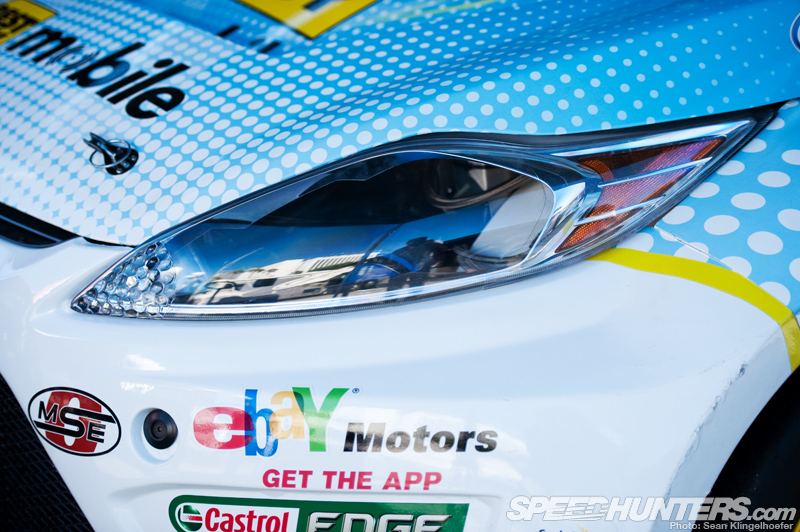
OMSE took this to the next level and have installed only the outer most portion of the factory lens. I thought this was super cool and kept coming back for a closer look throughout the weekend. Could this be the next show car trend?
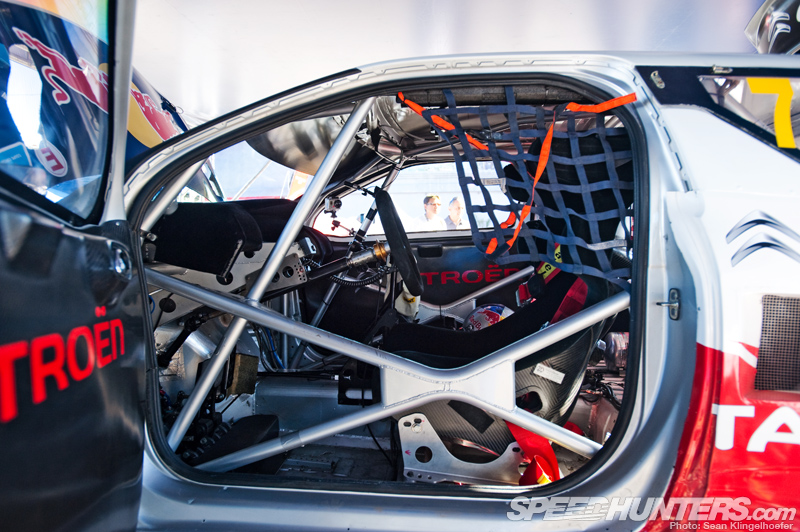
Rallycross thoroughly tests every aspect of the car, but if I had to pick a favorite I’d say it’s inside the cockpit where these cars really become their own. The roll cages are all drool-worthy in their own right, and I could probably spend a day just analyzing the cage constructions. Of course in an event with such great odds of crashing it would make sense that this is one area teams make sure to spend a lot of time on.
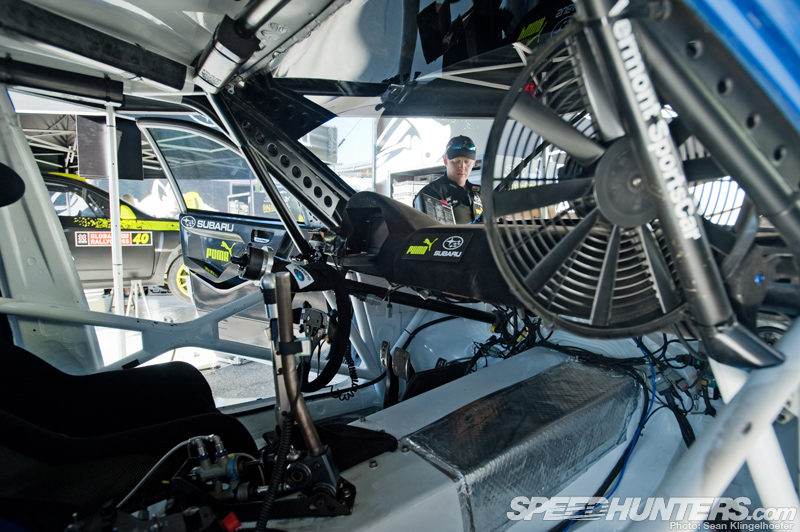
Needless to say there are other components resting within the safety zone. One feature that seemed to be consistent across the board was the use of a flocked-dash. Aside from looking pretty cool, flocking helps to eliminate any glare which is often kicked up onto the windscreen from a standard dash.
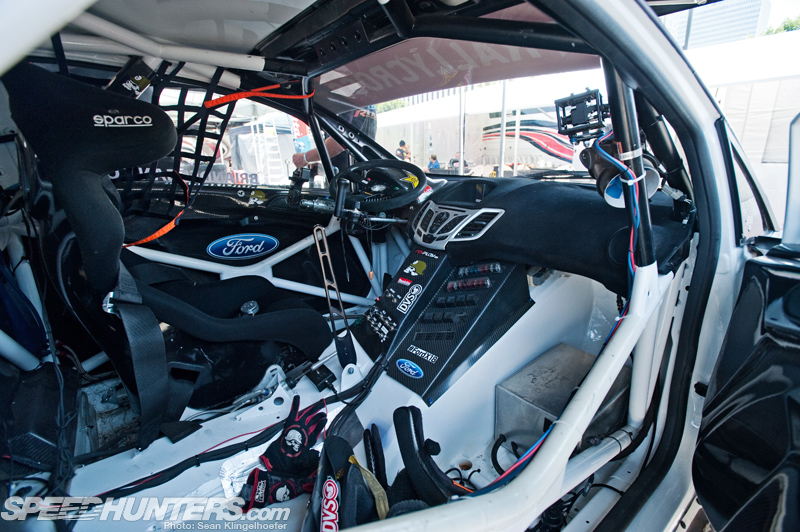
The shift levers however varied quite a bit from car to car. Like the placement of the engine, this revolves completely around the gear box which has been chosen. Some, like the Subaru one image back, utilize a standard style vertical lever for the sequential shifter. Others like Brian Deegan’s Ford Fiesta have a rod protruding from the dash with a pistol grip style lever.
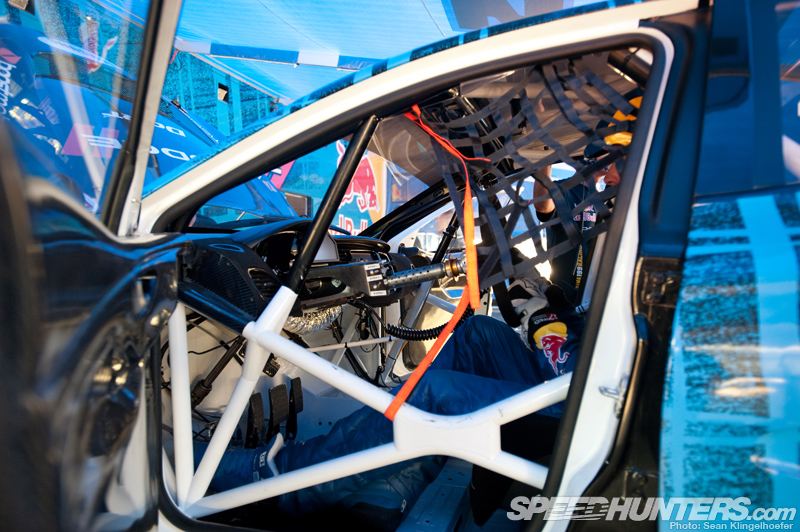
The seats in all the cars are moved back to fall roughly in line with the B-pillar of the car. This is mainly done as a safety precaution, although there is a slight weight distribution change, and is commonly seen in most major forms of motorsport. The new seating position requires a special longer racing steering column used in conjunction with a floor-mounted pedal box to keep the necessities within the driver’s reach.
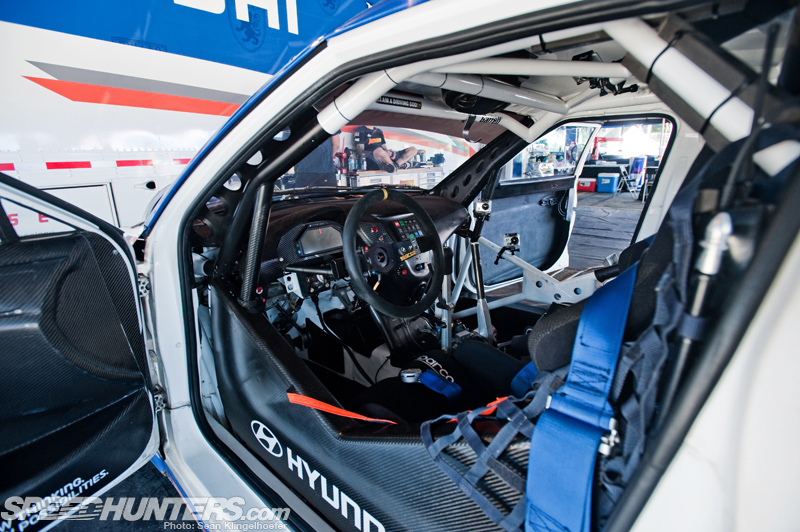
Sometimes the smallest details can take a car from functionally sound to incredible. Although I can’t speak to its performance advantages, I was really digging the carbon shroud around the door bars on Rhys’ Hyundai. Very cool.
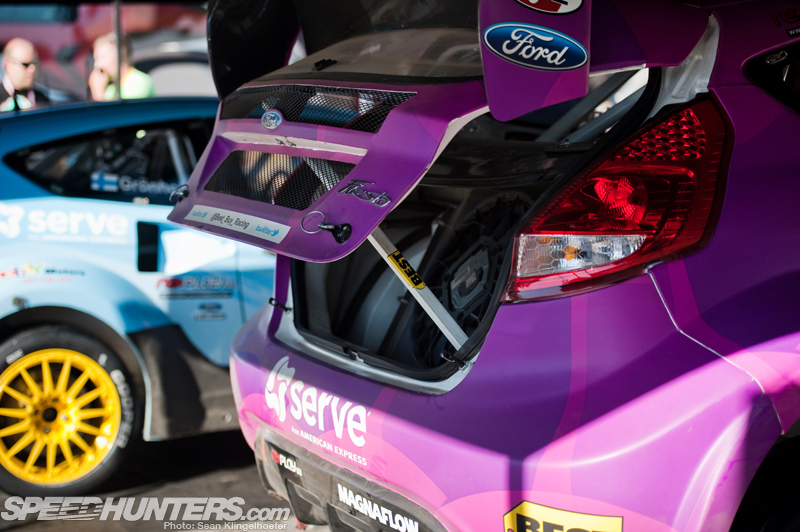
It wasn’t long before I realized that all of the cars were utilizing a rear-mounted radiator setup. It might seem like a strange way to route your cooling system, but it does have a few advantages, specifically for Rallycross.
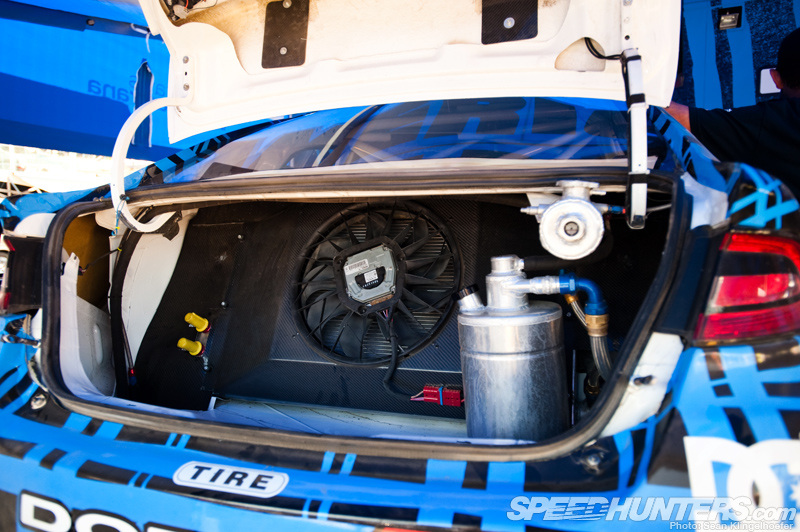
For starters the cars crash a lot, which we’ve already discussed. A radiator is a critical component to keep the car running, so keeping it out of harm’s way ensures better odds of reaching the finish line. Additionally many of the courses on the Rallycross tour are often very muddy so relocating the radiator prevents it from collecting a bunch of muck, thus robbing its cooling potential.
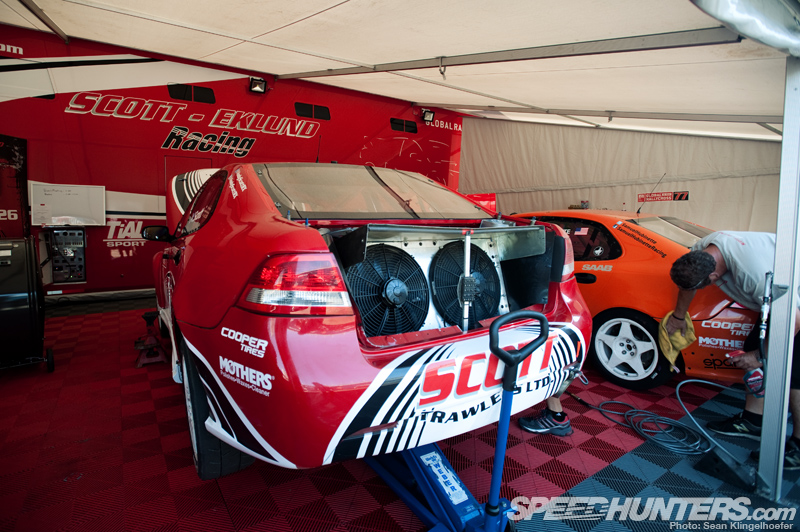
Moving the radiator out back also frees up more room in the front for a larger intercooler, which is always a welcome addition to a boosted race car.
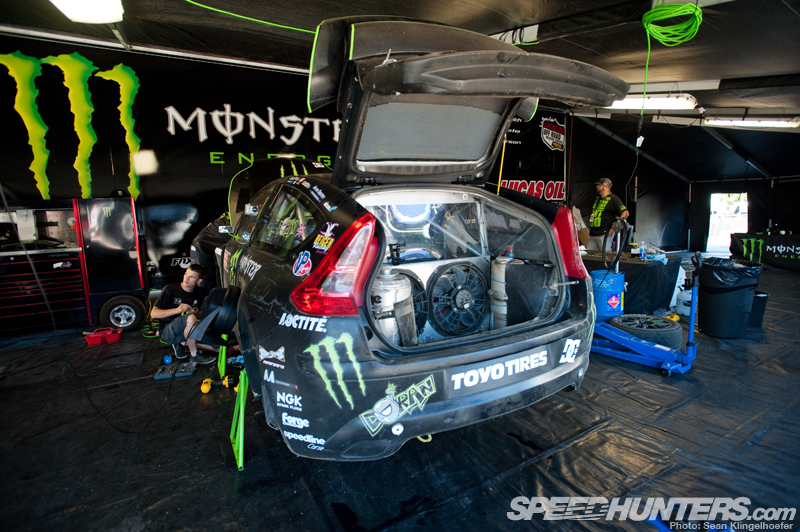
Finally moving the radiator and the coolant it contains to the back, can help to further offset weight for improved handling. At the end of the day that’s what it all boils down to anyway, handling.
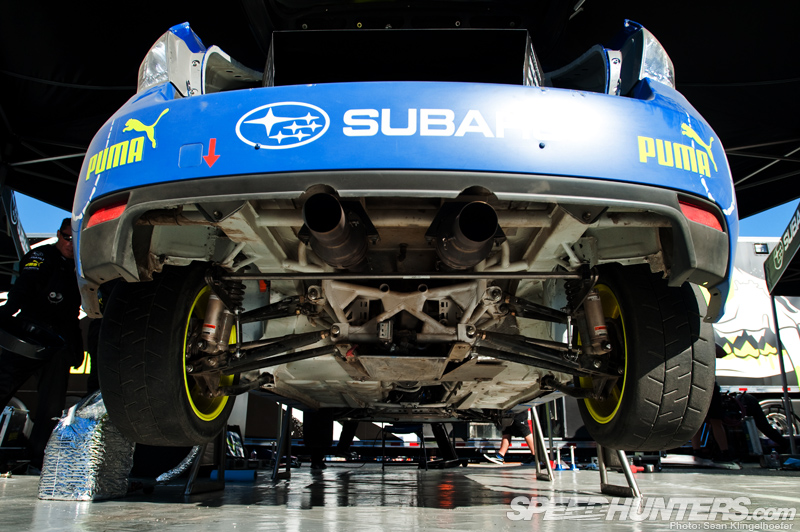
In a nut shell these cars have been created with one goal in mind, to be as darty as possible. Everything done to these cars is in pursuit of getting them to change direction as quickly as possible. If you ever have the opportunity to ride in one do it, your collar bones will hate you, but it’s an experience of a lifetime.
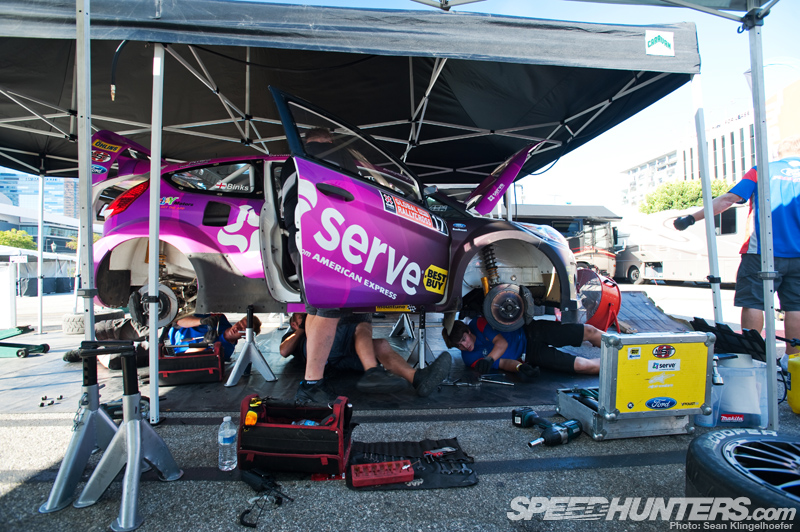
Until then, the next time you see an extreme sports athlete destroying one of these on television just remember all the work that went into it before hand. In my opinion the cars and the crews that support them are just as fascinating as the guy behind the wheel, even if they don’t go home with the gold medal.
More Rallycross stories on Speedhuters
More 101 stories on Speedhunters
More stories from Sean Klingelhoefer on Speedhunters
-Sean






This was a really cool post man... I enjoyed reading everything you wrote, but now my keyboard is all wet and about to short out from all the drool... More articles like this please!? Behind the scenes ftw!!
This was a really cool post man... I enjoyed reading everything you wrote, but now my keyboard is all wet and about to short out from all the drool... More articles like this please!? Behind the scenes ftw!!
This was a really cool post man... I enjoyed reading everything you wrote, but now my keyboard is all wet and about to short out from all the drool... More articles like this please!? Behind the scenes ftw!!
i dont understand why their all uneven, but apparently the commentators called Loeb an X games 'rookie' ummm yea, that doesnt mean anything.
I really enjoyed reading this! I love it when Speedhunters shows us the details mere mortals rarely get close enough to see like this... Good job!
@BigJames Sometimes I just try to make the kind of post I would like to see. Some of this stuff is really difficult to find pictures of so I figured I might as well share it. There's some really cool stuff under the skin on any competition car.
Did you see how bored he looked on the in-car footage after the first lap? hahaha.
@datsunsss Fear not for I plan on doing many features like this throughout the year on various types of racing. Keep your eyes peeled
@sean klingelhoefer The phrase "makes it look easy" comes to mind...
@sean klingelhoefer @BigJames Very good article but could you please give us a high res of Loeb's Engine bay?? Looks like there is some very interesting stuff in there and would love to take a better look at it.
It may have been a better fight if Marcus had not had his wreck.
The 'Unsung Hero'? Not for me, the machine is the coolest part of this sport imo! Awesome post although I ABSOLUTELY HATE headlight stickers...=P
When I said "unsung hero" I was referring to what the general public sees on the broadcast. There is so much talk about the drivers and interviews with them but very little about the cars they're driving.
@sean klingelhoefer Fair enough. Would love to see features on all of them! =D
Sean, great write up and insight into these beasts. I've had the pleasure of working on one and they are pretty amazing. The carbon cage cover on Rhys' car actually has a honeycomb side impact structure inside so it does have some use:) WRCars require that, whether it is in the door or cage. The Velosters they use are essentially re-bodied Ex-MSD Accent WRCars so a lot of the bits are early 2000s WRC technology.
Very nice feature. I love seeing what's under the hood.
Great feature! The people on speedhunters who are here for the right reasons (learning about other car cultures, keeping up with their favorites, and NOT trolling on everything that is different or they don't understand) are real car nuts. And real car nuts (myself included...) like to get down and dirty with the details of race cars, custon builds, etc. Too much focus is usually put on the superficial and that's not how cars are. They are mechanical creations made up of nuts and bolts, forged, cast, and pressed metal. I love finding out what makes these awesome machines tick, and I'm glad speedhunters is starting to focus more on these kinds of technical spotlights. Keep serving them up!!!!!
Great feature! The people on speedhunters who are here for the right reasons (learning about other car cultures, keeping up with their favorites, and NOT trolling on everything that is different or they don't understand) are real car nuts. And real car nuts (myself included...) like to get down and dirty with the details of race cars, custon builds, etc. Too much focus is usually put on the superficial and that's not how cars are. They are mechanical creations made up of nuts and bolts, forged, cast, and pressed metal. I love finding out what makes these awesome machines tick, and I'm glad speedhunters is starting to focus more on these kinds of technical spotlights. Keep serving them up!!!!!
@sean klingelhoefer Nice man! I can't wait!!
@sean klingelhoefer Nice man! I can't wait!!
@bill_dentsport That must have been an incredible experience! Very interesting about the cover, I had a sneaking suspicion that it probably did something, I just wasn't sure. Very interesting to hear about the development of the Veloster, but it does make sense, especially in terms of cost.
Also I couldn't help but notice your user name, is that dentsport as in DSG?
@bill_dentsport That must have been an incredible experience! Very interesting about the cover, I had a sneaking suspicion that it probably did something, I just wasn't sure. Very interesting to hear about the development of the Veloster, but it does make sense, especially in terms of cost.
Also I couldn't help but notice your user name, is that dentsport as in DSG?
@Eurotrash86 I'm really glad to hear you guys like this style of post since this is one part of motorsport I find most interesting. As I mentioned before there will be plenty of articles like this sprinkled in throughout the year.
@Eurotrash86 I'm really glad to hear you guys like this style of post since this is one part of motorsport I find most interesting. As I mentioned before there will be plenty of articles like this sprinkled in throughout the year.
@sean klingelhoefer Sean, it is DSG:)
@sean klingelhoefer Sean, it is DSG:)
Thought I would provide some insight incase people were unaware of this: When I was back east I hung out with some guys who were big into dirt oval karting and the southerners take their racing very seriously.
They were mandated a "spec tire" but would use a concoction of chemicals to "prep" the tires that would allow 5-10 laps of better grip than if the tire was left untouched. They would slather the tire with this chemical and then put it in a rotisserie style oven that would cook the prep into the tire. The prep can be smelled, but some guys apparently found ways to mask it or use prep that wouldn't emit any odors.
So just because these guys are on a "spec tire" doesn't mean all their tires are gripping equally. Just thought I would comment on that.
Thought I would provide some insight incase people were unaware of this: When I was back east I hung out with some guys who were big into dirt oval karting and the southerners take their racing very seriously.
They were mandated a "spec tire" but would use a concoction of chemicals to "prep" the tires that would allow 5-10 laps of better grip than if the tire was left untouched. They would slather the tire with this chemical and then put it in a rotisserie style oven that would cook the prep into the tire. The prep can be smelled, but some guys apparently found ways to mask it or use prep that wouldn't emit any odors.
So just because these guys are on a "spec tire" doesn't mean all their tires are gripping equally. Just thought I would comment on that.
With an anti lag system the biggest concern is heat to the actual turbine wheel itself. There are various ways to make an ALS and some are a bit more refined than others like Ferraris experimental ALS they used in F1. Any idea what style of ALS these cars are running?
With an anti lag system the biggest concern is heat to the actual turbine wheel itself. There are various ways to make an ALS and some are a bit more refined than others like Ferraris experimental ALS they used in F1. Any idea what style of ALS these cars are running?
Great article, i love seeing engine bay shots!!
Just one thing, you forgot that along with the SAAB and Ford, the Subaru is a longitudinal engine layout.
sorry if I'm nit picking! apart from that it was amazing
Great article, i love seeing engine bay shots!!
Just one thing, you forgot that along with the SAAB and Ford, the Subaru is a longitudinal engine layout.
sorry if I'm nit picking! apart from that it was amazing
Great writeup!
That's true about the Subaru, I just discounted it since it's a flat-4 instead of an inline, but you are correct!
I'm not sure but I can do some digging around. Could be an interesting subject for a future article.
I used to do something quite similar when I used to race R/C cars. We would clean the tire to strip any oils from the molding process, scuff them, treat them and then warm them. Although I didn't see anything at X Games that leads me to believe they have taken it to that extreme... yet.
@bill_dentsport Very cool, you guys build some cool stuff.
@zackspeed333 @BigJames Ask and occasionally you shall receive...
http://cdn.dev.speedhunters.com/wp-content/uploads/2012/07/D306468.jpg
@sean klingelhoefer @BigJames Awesome!!!! This place is the best!!
I sincerely hope you'll break from the crowd, and discuss homologation rules.
Audi, Subaru and Mitsubishi used rally as a testbed for cars that us speedhunters COULD ACTUALLY BUY.
Ford, Citroen and Peugeot want all the benefits of the marketing hype, without giving us the cosworths or RS's.
Nobody is taking them to task!
If you're going to bother with rally at all, please at least mention the important stuff.
@bakayaru HAVE TO AGREE! Am sick of the whole 'Marketing Strategies' they are using...Never give the enthusiast the real deal! And that's why I really don't follow rally much...
@sean klingelhoefer There was a big RC racing community in the town I lived in back east and they did the same thing! The thing is if they are doing it at X games you wouldn't see it. They aren't going to be prepping their tires out in the open for all to see.
@sean klingelhoefer There was a big RC racing community in the town I lived in back east and they did the same thing! The thing is if they are doing it at X games you wouldn't see it. They aren't going to be prepping their tires out in the open for all to see.
@sean klingelhoefer There was a big RC racing community in the town I lived in back east and they did the same thing! The thing is if they are doing it at X games you wouldn't see it. They aren't going to be prepping their tires out in the open for all to see.
I really hate the faux lights, especially the obvious ones (DS3). They make the car look non-production. With true lights, cars look like real cars. Plus, rallycross will surely move into night races, and having actual lights makes them look cooler.
I really hate the faux lights, especially the obvious ones (DS3). They make the car look non-production. With true lights, cars look like real cars. Plus, rallycross will surely move into night races, and having actual lights makes them look cooler.
@sean klingelhoefer
Thanks Sean. You are welcome to come by the shop if you are ever in the Northeast. New England Forest Rally is next weekend:)
Fresh air systems were banned a few years ago in ERC so most cars are using an electronic high volume air bypass valve combined with the associated ECU mapping. Subaru/VT Sportscar uses a fresh air/egr similar to the WRC Impreza rocket system used on S10+. Every car on the grid uses a Garrett TR30R based turbo and the turbine is designed for very aggressive shock-loading and temps.
The 80s turbo F1 method of choking the compressor (with a throttle plate pre-compressor) and over spinning during throttle tip in was very rudimentary but given the electronics available at the time probably as much as they could do. On the other hand, The fresh air/egr antilag method was pioneered by Audi Sport starting as early as 85 with the 1st version of the sport quattro on BRC events and then WRC events in late 85 (and then 86) with the E2. They needed electronics for that to work so I guess the technology was there, just not in F1.
@NaBUru38 They are actually not allowed to use headlights in ERC and GRC, or any proper rallycross for that matter. With the contact between cars, the lights would be lucky to last 1 lap, let alone an entire race. The lights are almost always just colored with the exterior paint or vinyl so it's kind of nice to see some kind of resemblance to their street counterparts with faux light vinyl.
whats the use of the clutch pedal if they have sequential boxes?
to start off from a stop, rev match (if not controlled by ecu) , clutch kick etc.
to start off from a stop, rev match (if not controlled by ecu) , clutch kick etc.